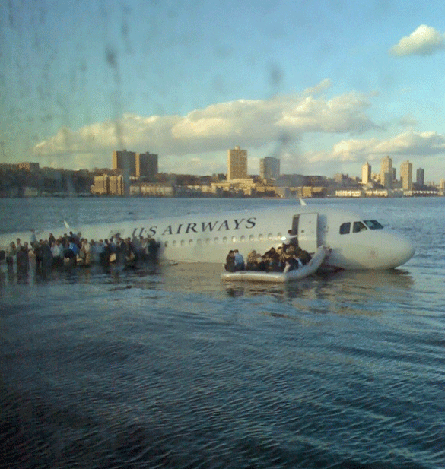Sources close to the investigation of the US Airways Flight 1549 ditching say the Airbus A320's left engine continued to run at about 35% fan speed (N1) during the 3min window between striking birds at 3,200ft (975m) and setting down on the Hudson river.
All 150 passengers and five crew safely disembarked from the Charlotte-bound aircraft in the river, aided by nearby ferry boat crews in a spectacle that captured global interest and fuelled renewed respect for airline training and professionalism.
Although limited, the left engine's speed would have been adequate to keep the aircraft's generators and hydraulic systems online, providing "normal" flight control laws, communications and intercom, and the ability to deploy flaps and slats, elements that proved critical to performing a low-speed water landing. To maintain altitude on a single engine, experts say the powerplant would have had to have been running at 70% N1 or more.
Investigators planned to retrieve the left engine, which broke from the aircraft during the ditching, from the river bottom on Friday or Saturday to perform an inspection. Flight International has learned that the aircraft touched down at 125-130kt (220-240km/h) air speed with flaps and slats both in the "2" position, or midpoint, position. An A320 normally lands at 120-125kt with fully deployed flaps and slats.
 |
|---|
© Janis Krums |
The right engine, which remained attached to the aircraft after ditching, was apparently operating at only 15% fan speed, according to sources. Investigators afterward determined that the engine had received "soft body impact damage" to its first-stage fan blades. In addition three variable guide vanes were fractured and two were missing. The engine's electronic control unit was missing and "numerous" internal components were "significantly" damaged, says the National Transportation Safety Board.
The NTSB says the "organic material" that was found in the right engine and on the wings and fuselage after the aircraft was lifted onto a barge will be identified through DNA analysis, and a feather found attached to the flap track on the wing has been sent to the Smithsonian Institution for identification.
The NTSB has also confirmed that the A320's Hamilton Sundstrand-built ram air turbine (RAT) had deployed from its compartment near the root of the left wing during the event. Although it will deploy automatically when engine or electric power drops below a threshold, pilots can also manually deploy the RAT as well. The device provides power to one of three hydraulic systems on board, which would have given pilots the ability to deploy slats, but most likely not flaps.
Sources have told Flight International that the first officer had tried to relight the left engine during the descent, which averaged 1,000ft/min (5.08m/s), but that the engine continued to rotate at 35% N1.
Pilots review ditching procedures from manuals but do not practise the events in simulators as there are no test-verified models available. Pilots do, however, practise double engine-out scenarios with a relight afterward. NTSB has completed its interviews of the pilots, flight attendants and air traffic controllers and was working to wrap up its fact finding with passengers and a crew that two days earlier experienced a compressor stall on the accident aircraft. That event does not appear to be related to the 15 January accident.
Although US Airways provides all seats in its pre-America West merger A320s with life vests, which includes the accident aircraft, a former A320 captain has told Flight International there would not have been time to fly, assess the aircraft's condition, decide on a course of action and then fully brief the passengers.
Pilots also did not activate the A320's "ditch" button, which automatically closes a number of vent apertures, a preparation that the former A320 captain says is about three pages into the ditching checklist. "Some of the flight attendants didn't even know they were going into the water," he says of the 3min timeframe during the descent. "There was not enough time for any of it."
- Read David Learmount's blog, Learmount: Ditching as an informed choice
Source: Flight International























